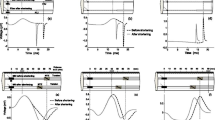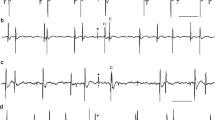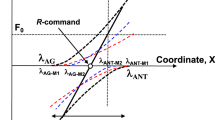Abstract
Synchronous activity was studied in relation to the contractile properties of pairs of motor units (MUs) recorded with independent microelectrodes in the right extensor digitorum communis muscle (EDC) of human subjects during isometric finger extension. MU contrac tile properties were characterized in terms of the rise time and amplitude of twitch tensions extracted by spike-trig gered averages of the extension force. Synchronization of MU discharges appeared in the form of narrow central peaks in the cross-correlograms of 35 of 50 pairs of MUs, suggesting the contribution of common last-order neu rons. Synchronization peaks tended to be briefer and higher among pairs of MUs with slower and smaller twitches than among pairs of MUs with faster and larger twitches. The higher peaks of slow-contracting MUs sug gest a greater effectiveness of the common synaptic in puts. The broader peaks of fast-contracting MUs might reflect an additional synchronization of the inputs to fast MUs at high force levels. The areas of the cross-correlo gram peaks were similar for both groups and suggest that under our conditions, about three motoneurons would discharge synchronously for a given motoneuron spike. To test whether the amount of MU synchronization could be altered voluntarily, four subjects attempted to increase or decrease synchrony, using as feedback clicks triggered by coincident firings of the recorded MUs. In nine of 15 conditioning sessions, the magnitudes of the synchronization peaks showed significant changes in the intended direction. These results imply that supraspinal centers can control the relative amount of inputs that contribute to the synchronization of motoneuron dis charges during voluntary contraction of EDC.
Similar content being viewed by others
References
Adam D, Windhorst U, Inbar GF (1978) The effects of recurrent inhibition in the cross-correlated firing patterns of motoneurons. Biol Cybern 29:209–235
Adams L, Datta AK, Guz A (1989) Synchronization of motor unit firing during different respiratory and postural tasks in human sternocleidomastoid muscle. J Physiol (Lond) 413:213–231
Baker JR, Davey NJ, Ellaway PH, Friedland CL (1992) Short-term synchrony of motor unit discharge during weak isometric contraction in Parkinson's disease. Brain 115:137–154
Bremner FD, Baker JR, Stephens JA (1991a) Correlation between the discharges of motor units recorded from the same and from different fingers muscles in man. J Physiol (Lond) 432:355–380
Bremner FD, Baker JR, Stephens JA (1991b) Variation in the degree of synchronization exhibited by motor units lying in different finger muscles in man. J Physiol (Lond) 432:381–399
Buchthal F, Madsen A (1950) Synchronous activity in normal and atrophic muscle. EEG Clin Neurophysiol 2:425–444
Calancie B, Bawa P (1986) Limitations of the spike-triggered averaging technique. Muscle Nerve 9:78–83
Clark FJ, Matthews PCB, Muir RB (1981) Motor unit firing and its relation to tremor in tonic vibration reflex of the decerebrate cat. J Physiol 313:317–334
Cope TC, Fetz EE, Matsumura M (1987) Cross-correlation assessment of synaptic strength of single Ia fibre connections with triceps surae motoneurones in cats. J Physiol (Lond) 390:161–188
Cox DR, Lewis PAW (1966) The statistical analysis of series of events. Methuen, London
Datta AK, Baker JR, Stephens JA (1986) A new technique to assess the ongoing short-term synchronization in individual motor units during different voluntary movements in man. J Physiol (Lond) 371:19P
Datta AK, Farmer SF, Stephens JA (1991) Central nervous pathways underlying synchronization of human motor unit firing studied during voluntary contractions. J Physiol (Lond) 432:401–425
Datta AK, Stephens JA (1990) Synchronization of motor unit activity during voluntary contraction in man. J Physiol (Lond) 422:397–419
Davey NJ, Ellaway PH (1988) Control from the brainstem of synchrony of discharge, between gamma-motoneurones in the cat. Exp Brain Res 72:249–263
Davey NJ, Ellaway PH, Friedland CL, Short DJ (1990) Motor unit discharge characteristics and short-term synchrony in paraplegic humans. J Neurol Neurosurg Psychiatry 53:764–769
Dengler R, Wolf W, Birk P, Struppler A (1984) Synchronous discharges in pairs of steadily firing motor units tend to form clusters. Neurosci Lett 47:167–172
Dengler R, Wolf W, Schubert M, Struppler A (1986) Discharge pattern of single motor units in basal ganglia disorder. Neurology 36:1061–1066
Dick TE (1990) Artifactual averaged ‘twitch tension’ waveforms resulting from synchronized activity: recording from feline diaphragmatic motor units. Neurosci Lett 114:57–62
Dietz V, Bischofberger E, Wita C, Freund HJ (1976) Correlation between the discharges of two simultaneously recorded motor units and physiological tremor. EEG Clin Neurophysiol 40:97–105
Eccles RM, Phillips CG, Wu CP (1968) Motor unit innervation, motor unit organization and afferent innervation of M extensor digitorum communis of the baboon's forearm. J Physiol (Lond) 198:179–192
Ellaway PH (1978) Cumulative sum technique and its application to the analysis of peristimulus histograms. EEG Clin Neurophysiol 45:302–304
Ellaway PH, Murthy KSK (1985) The origins and characteristics of cross-correlated activity between gamma-motoneurones in the cat. Quart J Exp Physiol 70:219–232
Fetz EE, Cheney PD (1980) Postspike facilitation of forelimb muscle activity by primate corticomotoneuronal cells. J Neurophysiol 44:751–772
Flament D, Fortier PA, Fetz EE (1992) Response patterns and post-spike effects of peripheral afferents in dorsal root ganglia of behaving monkeys. J Neurophysiol 67:875–889
Fortier PA, Flament D, Fetz EE (1989) Relationship between primate corticomotoneuronal cells and their target forearm motor units during torque tracking. Soc Neurosci Abstr 15:788
Garnett R, Stephens JA (1980) The reflex response of single motor units in human first dorsal interosseus muscle following cutaneous afferent stimulation. J Physiol (Lond) 303:351–364
Gelfand IM, Gurfinkel VS, Kots YM, Tstetlin ML, Shik ML (1963) Synchronization of motor units and associated motor concepts. Biofizika 8:475–487
Jenny AB, Inukai J (1983) Principles of motor organization of the monkey cervical spinal cord. J Neurosci 3:567–575
Johnson MA, Polgar J, Weightman D, Appleton D (1973) Data on the distribution of fibre types in thirty-six human muscles. J Neurol Sci 18:111–129
Kirkwood PA (1979) On the use of cross-correlation measurements in the mammalian central nervous system. J Neurosci Meth 1:107–132
Kirkwood PA, Sears TA (1991) Cross-correlation analyses of motoneuron inputs in a coordinated motor act. In: Krüger J (ed) Neuronal cooperativity. (Springer series in synergetics, vol 49) Springer, Berlin Heidelberg New York, pp 225–248
Kirkwood PA, Sears TA, Tuck DL, Westgaard RH (1982) Variations in the time course of the synchronization of intercostal motoneurons of the cat. J Physiol (Lond) 327:105–135
Lippold O, Redfearn JWT, Vuco J (1957) The rhythmical activity of groups of motor units in the voluntary contraction of muscles. J Physiol (Lond) 137:473–487
Mantel GWH, Lemon RN (1987) Cross-correlation reveals facilitation of single motor units in thenar muscles by single corticospinal neurons in the conscious monkey. Neurosci Lett 77:113–118
McCord H, Smith Jr, Basmajian JV, Vanderstoep SF (1974) Inhibition of neighboring motoneurons in conscious control of single spinal motoneurons. Science 183:975–976
Mendell LM, Henneman E (1971) Terminals of single Ia fibers: location, density and distribution within a pool of 300 homonymous motoneurons. J Neurophysiol 34:171–187
Milner-Brown HS, Stein RB, Yemm R (1973a) The contractile properties of human motor units during isometric contractions. J Physiol (Lond) 228:285–306
Milner-Brown HS, Stein RB, Yemm R (1973b) The orderly recruitment of human motor units during voluntary isometric contractions. J Physiol (Lond) 230:359–370
Milner-Brown HS, Stein RB, Lee RS (1975) Synchronization of human motor units: possible roles of exercise and supraspinal reflexes. EEG Clin Neurophysiol 38:245–254
Monster AW, Chan H (1977) Isometric force production by motor units in the extensor digitorum communis muscle. J Neurophysiol 40:1432–1443
Munson JB (1989) Synaptic input to type-identified motor units. In: Binder MD, Mendell LM (eds) The segmental motor system. Oxford University Press, Oxford, pp 297–307
Nordstrom MA, Miles TS, Veale JL (1989) Effect of motor unit firing pattern on twitches obtained by spike-triggered averaging. Muscle Nerve 12:556–567
Nordstrom MA, Miles TS, Türcker K (1990) Synchronization of motor units in human masseter during a prolonged isometric contraction. J Physiol (Lond) 426:409–421
Nordstrom MA, Fugelvand AJ, Enoka RM (1992) Estimating the strength of common input to human motoneurones from the cross-correlogram. J Physiol (Lond) 453:547–575
Phillips CG, Porter R (1977) Corticospinal neurons: their role in movement. Academic Press, London
Rick S, Bawa P (1992) Recruitment of motor units in human forearm extensors. J Neurophysiol 68:100–108
Rudomin P (1989) Presynaptic control of synaptic effectiveness of muscle spindle and tendon organ afferents in the mammalian spinal cord. In Binder MD, Mendell LM (eds) The segmental motor system. Oxford University Press, Oxford, pp 349–380
Schmied A, Vedel JP, Pagni S (1992) Comparison of the synchronization of human motor units during the voluntary contraction of the wrist extensor muscles in the preferred or the non-preferred arm. Soc Neurosci Abstr 18:861
Sears TA, Stagg D (1976) Short-term synchronization of intercostal motoneurone activity. J Physiol (Lond) 263:357–381
Snedecor GW, Cochran WG (1980) Statistical methods. Iowa University Press, Ames, Iowa
Thomas CK, Bigland-Ritchie B, Westling G, Johansson RS (1990) A comparison of human thenar motor-unit properties studied by intraneural motor-axon stimulation and spike-triggered averaging. J Neurophysiol 64:1347–1351
Author information
Authors and Affiliations
Rights and permissions
About this article
Cite this article
Schmied, A., Ivarsson, C. & Fetz, E.E. Short-term synchronization of motor units in human extensor digitorum communis muscle: relation to contractile properties and voluntary control. Exp Brain Res 97, 159–172 (1993). https://doi.org/10.1007/BF00228826
Issue Date:
DOI: https://doi.org/10.1007/BF00228826




